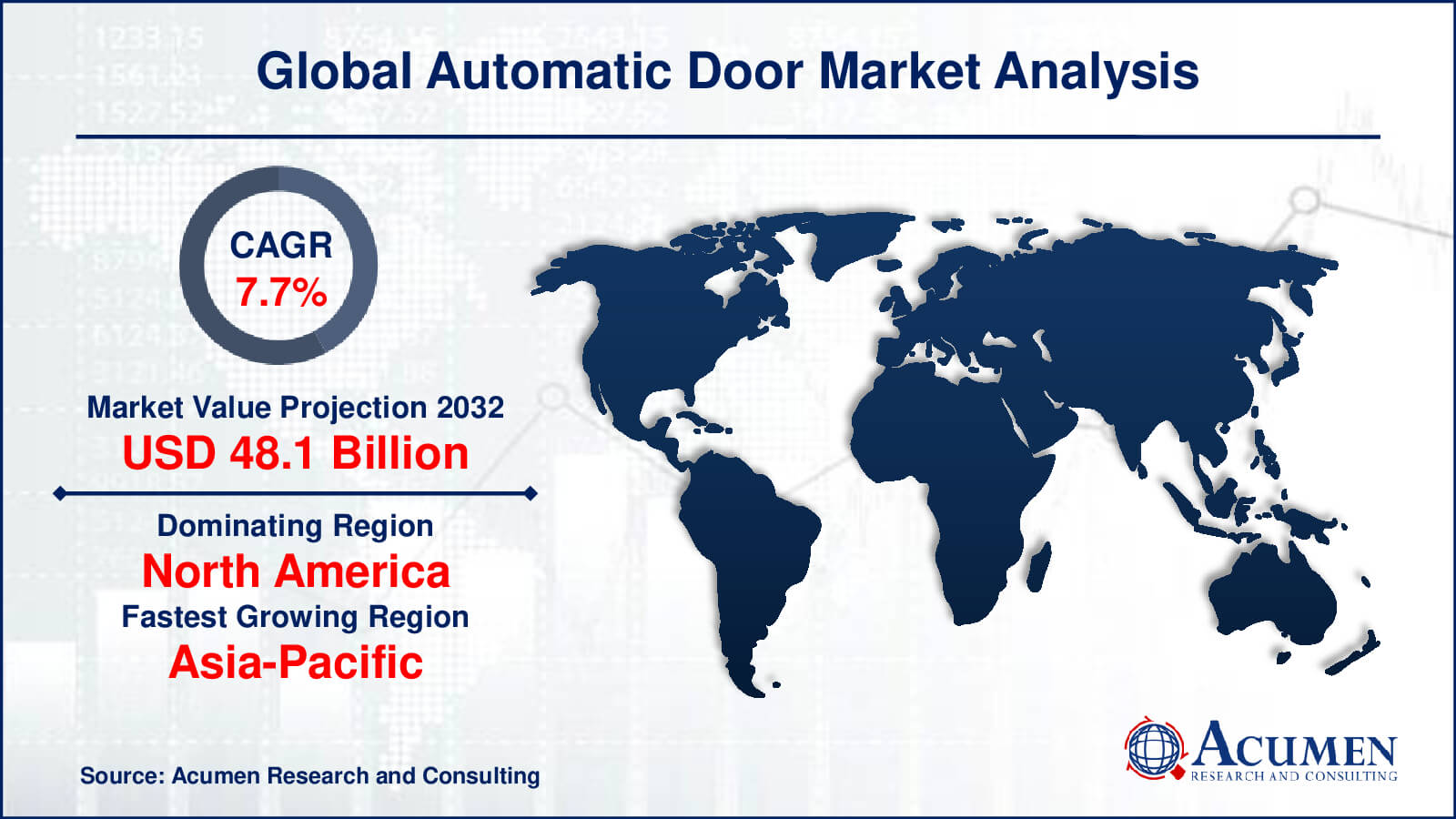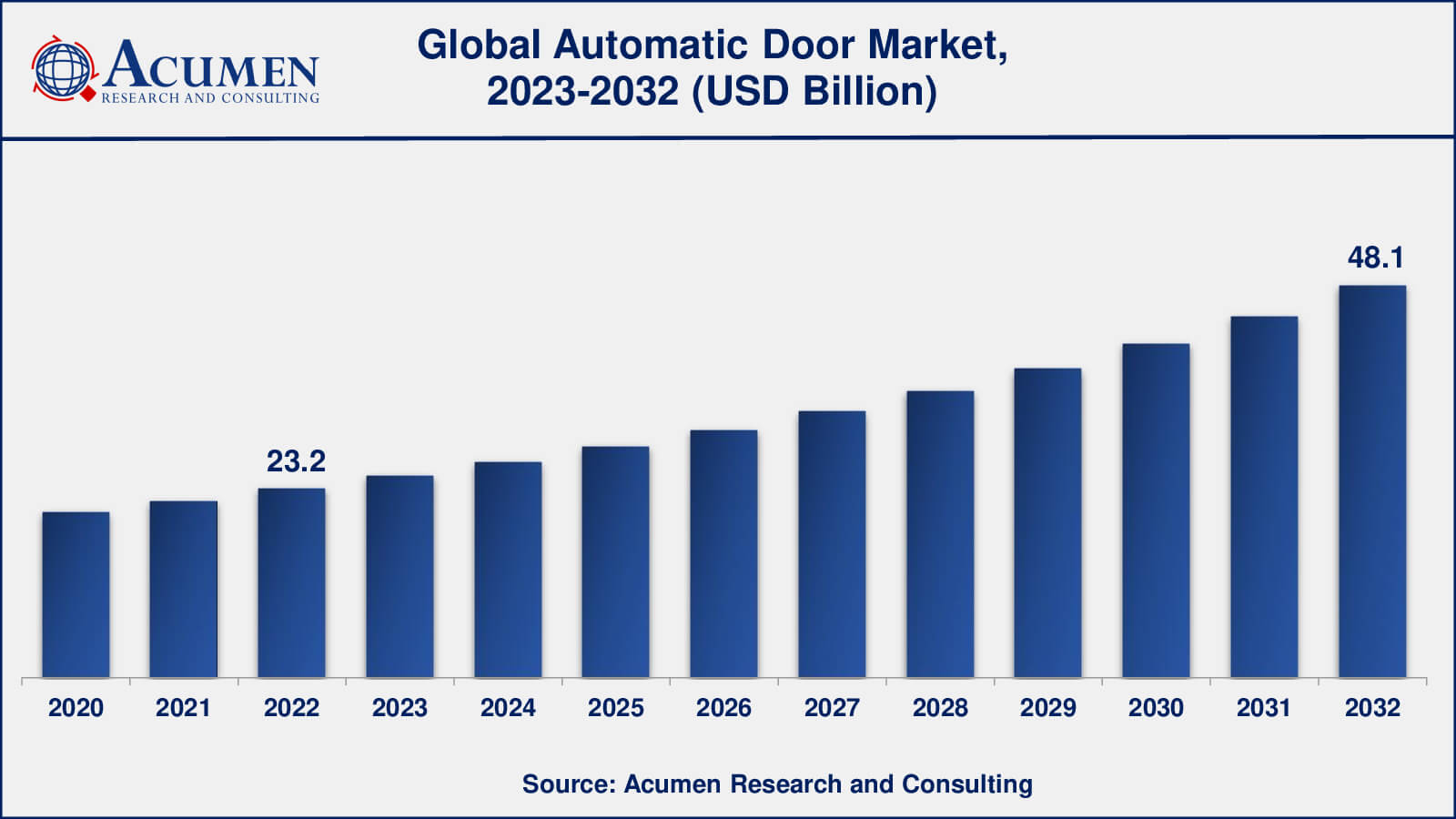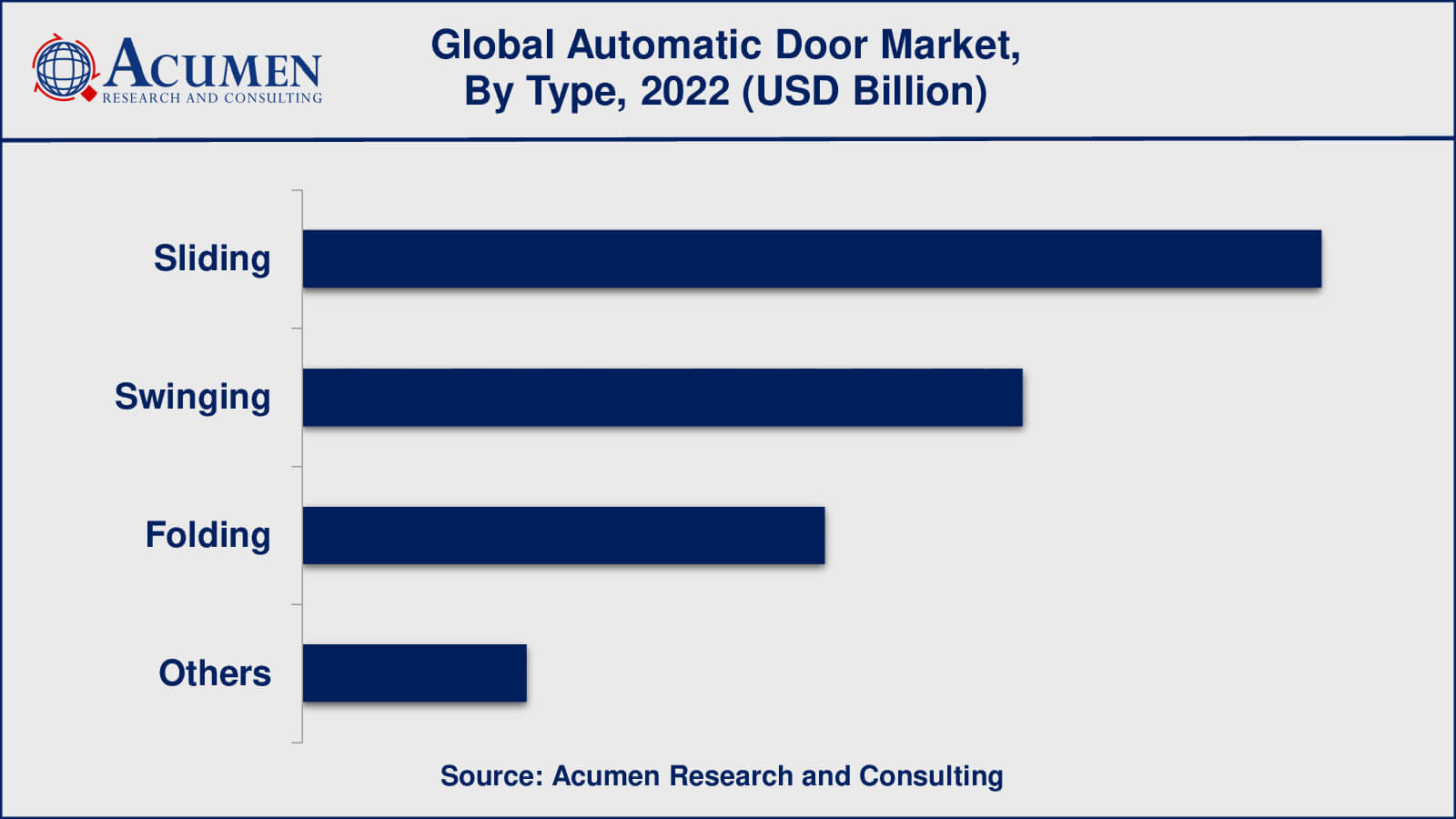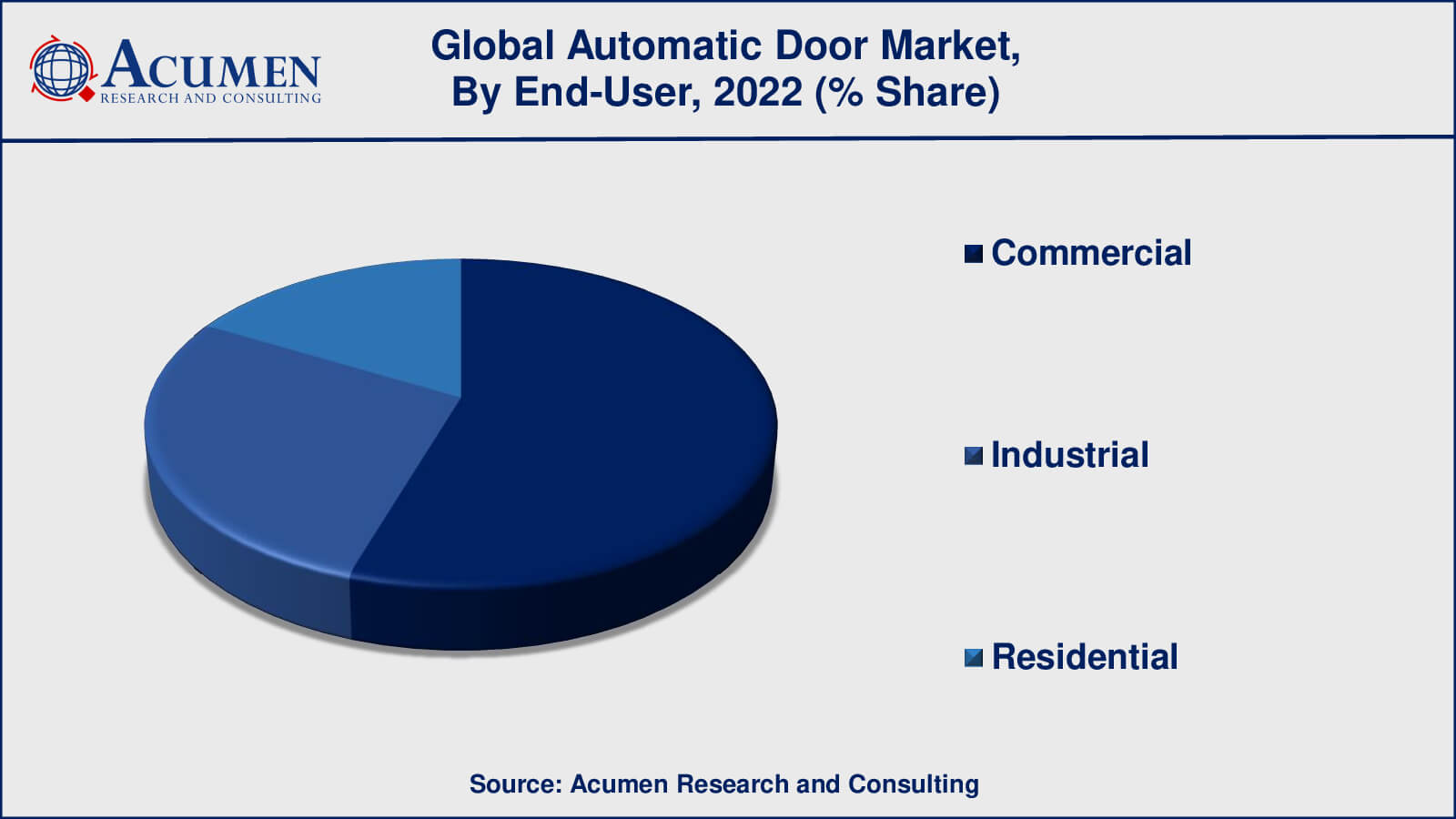February 2023
Automatic Door Market size was valued at USD 23.2 Billion in 2022 and is projected to attain USD 48.1 Billion by 2032 mounting at a CAGR of 7.7% from 2023 to 2032.
The global Automatic Door Market size was valued at USD 23.2 Billion in 2022 and is projected to attain USD 48.1 Billion by 2032 mounting at a CAGR of 7.7% from 2023 to 2032.
Automatic Door Market Highlights

An automated door is a form of entry or exit that automatically opens and closes without the need for manual action. It has sensors, control systems, and motorized mechanisms that allow it to sense the presence of people or objects and respond by opening or shutting the door. Automatic doors are extensively utilized in business buildings, hospitals, airports, hotels, retail establishments, and residential residences. Individuals, particularly those with mobility issues or impairments, benefit from the convenience and simplicity of access provided by these doors. They do not need physical effort to open or close doors, making them perfect for high-traffic areas or situations where hands-free operation is preferred. Automatic doors help to improve accessibility and ensure a smooth flow of people, particularly in public settings.
The operation of automated doors is based on a mix of technologies. Motion sensors, infrared sensors, and pressure sensors detect the presence of persons or things near the entrance. When someone approaches the door, the sensors send signals to the control system, which activates the motorized mechanism that opens and closes the door. The control system also has safety safeguards to keep the door from closing on people or objects in its passage.
Aside from ease, automatic doors have various advantages. Because they close automatically once a person goes through, they improve energy efficiency by reducing air conditioning or heating loss. This function aids in sustainability efforts by lowering energy use. Furthermore, automated doors can meet construction codes and accessibility rules, guaranteeing equitable access for all people, including those with impairments.

Global Automatic Door Market Dynamics
Market Drivers
Market Restraints
Market Opportunities
Automatic Door Market Report Coverage
| Market | Automatic Door Market |
| Automatic Door Market Size 2022 | USD 23.2 Billion |
| Automatic Door Market Forecast 2032 | USD 48.1 Billion |
| Automatic Door Market CAGR During 2023 - 2032 | 7.7% |
| Automatic Door Market Analysis Period | 2020 - 2032 |
| Automatic Door Market Base Year | 2022 |
| Automatic Door Market Forecast Data | 2023 - 2032 |
| Segments Covered | By Type, By End-User, And By Geography |
| Regional Scope | North America, Europe, Asia Pacific, Latin America, and Middle East & Africa |
| Key Companies Profiled | ASSA ABLOY Group, dormakaba Holding AG, Deutschtec GmbH, GEZE GmbH, Nabtesco Corporation, MANUSA GEST, S.L., Royal Boon Edam International B.V, Rite-Hite Holding Corporation, Sanwa Holdings Corporation, and Stanley Black & Decker, Inc. |
| Report Coverage |
Market Trends, Drivers, Restraints, Competitive Analysis, Player Profiling, Covid-19 Analysis, Regulation Analysis |
Automatic Door Market Insights
The growing need for convenience and greater accessibility is a crucial factor. Automatic doors give a hands-free and smooth experience, reducing the need for manual operation, as people seek more convenient solutions in their everyday lives. Furthermore, with an increasing emphasis on inclusion and accessibility, automated doors play an important role in allowing simple entry and departure for those with impairments or mobility issues.
Sensor technology and automation advancements have also moved the automated door market ahead. More advanced sensors, such as motion sensors, infrared sensors, and pressure sensors, have enhanced the accuracy and responsiveness of automatic door systems. This, together with automated control systems and motorized mechanisms, guarantees that operations run smoothly and efficiently. As these technologies advance, automatic doors become more dependable and user-friendly.
Another motivator is the presence of severe accessibility standards and norms in public settings. Governments and regulatory agencies all around the globe have recognized the significance of equitable access for all people, leading to the adoption of accessibility standards. Automatic doors provide a practical option for ensuring that public buildings, organizations, and commercial spaces give quick and barrier-free access.
The use of automated doors in commercial and residential buildings has increased steadily. Automatic doors have been used by the commercial sector, including retail establishments, airports, hospitals, and hotels, since they improve customer experience, optimize traffic flow, and contribute to a contemporary and technologically sophisticated environment. The demand for convenience and an up market appeal is also driving the use of automated doors in residential homes.
Despite these favorable factors, the automatic door business confronts certain challenges. Some potential consumers may be put off by the high initial installation and maintenance expenses, particularly small businesses or households. The integration of sensors, control systems, and motors, as well as the technical difficulties connected with automatic doors, may pose dependability problems, necessitating frequent maintenance and specialized specialists for upkeep.
Compatibility with current infrastructure can be difficult, especially in older buildings that were not constructed with automated doors in mind. Because sensors and control systems may gather and send data, privacy and security concerns must also be addressed. End-user awareness and comprehension, including correct usage and safety considerations, are critical for maximizing the benefits of automated doors.
Despite these limitations, the automated door industry is expanding owing to technological developments, rising demand for accessibility and convenience, and regulatory regulations. Integration with smart building systems and IoT technology opens up new possibilities for automated doors, allowing them to be part of networked and intelligent infrastructures. Additionally, the growth of diverse industries such as retail, healthcare, and hospitality, as well as urbanization and infrastructure development projects, creates prospective markets for automatic door manufacturers and suppliers.
Automatic Door Market Segmentation
The worldwide market for automatic door is split based on type, end-user, and geography.
Automatic Door Types

According to the automatic door industry analysis, the sliding doors are widely used in commercial buildings, retail stores, airports, and healthcare facilities, among others. They provide a smooth and efficient functioning, letting humans or items to enter and depart with ease. Sliding doors are especially popular in high-traffic areas with a high volume of people passing through since they have a broad aperture and can handle simultaneous entry and departures.
Swinging doors are also prevalent in the automated door business. They are typically found in stores, restaurants, and office buildings. Swinging doors give a conventional and familiar entering experience, and they are frequently favoured in situations requiring a more aesthetic or architectural design.
In recent years, folding doors, also known as bi-fold or accordion doors, have grown in popularity. They are frequently utilised in areas where a larger entrance is required yet space is restricted. Folding doors are used at airports, retail malls, and convention centers. Because they fold and stack to the side while the door is open, they provide a compact and space-saving option.
Automatic Door End-Users

As per the automatic door market forecast, the commercial end-user is expected to gather utmost shares from 2023 to 2032. Retail stores, shopping malls, hotels, restaurants, airports, office buildings, and healthcare institutions are all places where automatic doors are employed. The ease, accessibility, and efficient traffic flow afforded by automated doors assist the business sector tremendously. They improve the client experience, increase foot traffic, and contribute to a more contemporary, technologically sophisticated atmosphere.
While the commercial sector accounts for a sizable portion, the industrial sector is also a big end-user of automated doors. Automatic doors are used in industries such as manufacturing, warehouses, logistics centres, and distribution hubs to facilitate the flow of goods, equipment, and staff. Industrial-grade automated doors are built to resist severe use while also providing security and facilitating seamless operation in industrial settings.
Although the residential sector is a smaller market segment than the commercial and industrial sectors, it has seen an increase in the usage of automated doors. High-end mansions, luxury flats, and gated communities have all adopted automated doors for their convenience, security, and aesthetic appeal. Automatic doors give homeowners hands-free entry while also increasing the overall value and modernity of residential homes.
Automatic Door Market Regional Outlook
North America
Europe
Asia-Pacific
Latin America
The Middle East & Africa
Automatic Door Market Regional Analysis
The North American market for automatic doors is considerable, with factors such as tight accessibility rules, modern infrastructure, and a high degree of awareness and acceptance of automated technology driving growth. With applications in commercial buildings, healthcare institutions, and public places, the United States and Canada are important contributors to market growth.
Europe's automated door market is mature, with a significant emphasis on energy efficiency and sustainability. Countries like as Germany, the United Kingdom, France, and Italy have seen extensive use of automated doors, owing to stringent regulations, an increased emphasis on smart building solutions, and a growing commercial sector.
The Asia-Pacific region's automated door industry is expanding rapidly, owing mostly to urbanization, infrastructural development, and rising disposable income. China, Japan, South Korea, and India are important markets with high demand for automated doors in commercial buildings, airports, and hotels.
Automatic Door Market Players
Some of the top automatic door companies offered in our report include ASSA ABLOY Group, dormakaba Holding AG, Deutschtec GmbH, GEZE GmbH, Nabtesco Corporation, MANUSA GEST, S.L., Royal Boon Edam International B.V, Rite-Hite Holding Corporation, Sanwa Holdings Corporation, and Stanley Black & Decker, Inc.
Automatic Door Industry Recent Developments
Looking for discounts, bulk pricing, or custom solutions? Contact us today at sales@acumenresearchandconsulting.com
February 2023
July 2022
December 2020
April 2025